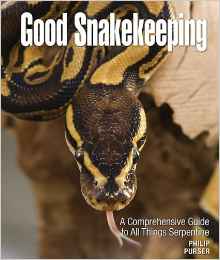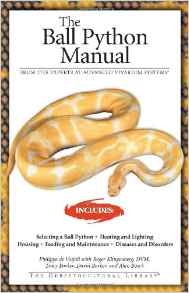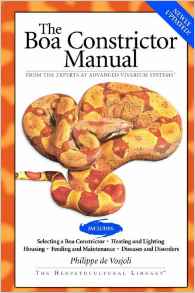Reptiles and amphibians: Books about Snakes
If you want to buy a book, clicking on the book cover will take you directly to that book on the Amazon.co.uk web site.
See also:
- Books on lizards
- Books on tortoises, turtles and terrapins
- Books on amphibians
- Click here for advice on lizards and snakes
- Click here for advice on tortoises and turtles
- Click here for advice on amphibians
- News and research: Reptiles and Amphibians: General Articles
- News and research: Reptiles and Amphibians: Health, disease and physiology

Snakes
This book is a guide to the origins and biology of snakes from three herpetologists at the Natural History Museum. It’s geared to anyone who’s interested in snakes, rather than just people who want to keep them as pets, though anyone considering buying a snake would benefit from reading this book.
‘Snakes’ gives a fascinating account of how snakes evolved, and how they perceive the world – their senses are different from ours. Some snakes can detect the heat of warm-blooded creatures, and all snakes can detect prey by smell. They are also more sensitive than we are to vibrations. This is why pet snakes can be upset if they’re kept in a place where their ‘ground’ seems to be constantly vibrating, and it’s kinder to wear soft-soled shoes near a vivarium. There’s also an account of snake reproduction, again, interesting in itself, and useful for people who keep snakes.
There are some 3,000 species of snakes, which differ a lot in their lifestyle, behaviour and habitats, and much of ‘Snakes’ explains these differences. This information is interesting if you just want to understand snakes, and is especially useful if you’re thinking of keeping one. ‘Snakes’ is an ideal gift for a young person interested in biology. It’s nicely written, well-illustrated, and has a glossary which explains technical terms. It’s also an invaluable source of background information for people interested in keeping snakes.

Good Snakekeeping
‘Good Snakekeeping’ is a guide to choosing and keeping snakes for novices, which sets out clearly the tasks you’ll have to do every day, and every now and then, if you plan on keeping a snake. It contains essential information that you need to work out if you have enough time, energy and space to keep a snake healthy and happy, and to help you plan for holidays and busy times if you’ve already bought a snake.
‘Good Snakekeeping’ is unlikely to tell experienced snake keepers anything they don’t know, and there’s not much on snake behaviour. However, it’s a particularly useful clear guide for people starting out with their first snakes.

What's Wrong with My Snake? (Herpetocultural Library)
‘What’s Wrong with My Snake?’ is a very handy reference book giving veterinary advice for snake keepers. It covers a wide range of health problems, including respiratory infections, parasite infestations, and loss of appetite, and there’s also help with behavioural issues like aggression.
The book is well organised, so it is easy to find what you’re looking for in an emergency. There are charts for quick reference, and illustrations to help with diagnosing problems. Some solutions are offered, when it’s easy to tackle a problem yourself, and there’s also advice on which signs and symptoms mean that you really need help from a vet.
Perhaps the most important part of ‘What’s Wrong with My Snake?’ is the advice on prevention, since many health problems can be prevented by providing the right environment and making sure that snakes aren’t stressed out. There are also ponters to further reading which you can follow up online. This is a very useful reference book for both novice and experienced snake owners.

Ball Python Manual (Herpetocultural Library)
Ball pythons are a popular first choice for people keeping snakes. They’re very beautiful and are quite big, though not as large as some of the python family. They tend to be easy to handle once they’ve got used to contact with humans. However, they can suffer from stress, and refuse to eat. They may also wind themselves up tightly when they’re scared, which is why they’re called 'ball pythons'. They’re long-lived snakes, so taking one on is a serious commitment.
'Ball Python Manual’ is a good basic guide to caring for these snakes. There’s help with feeding, including reluctance to eat, on gentle and firm handling, providing the right home for a ball python, and tackling and preventing health problems. There’s also help with breeding. ‘Ball Python Manual’ is pretty basic, and focuses more on snakes born in the wild, but it’s an inexpensive book, and is good value for a novice.

Boa Constrictor Manual (Advanced Vivarium Systems)
Boa constrictors are big snakes, though not quite as big as Burmese pythons. They kill prey by squeezing it, but they’re usually quite easy to handle so long as you use common sense and don't frighten them. Keeping them relaxed is especially important for young snakes and those that aren’t used to being handled. This guide gives you a lot of good advice on handling your snake, and all other aspects of care, like providing the right temperature and lighting, feeding, and type of enclosure.
‘Boa Constrictor Manual’ is especially useful for diagnosing and treating infections and other health problems, and checking for signs that you may need to call a vet. There’s advice on breeding, which may not be especially helpful if you can’t find takers for the baby snakes! These are animals that need responsible owners, and you need a lot of space if you can’t find homes as soon as your snakes are ready to leave you.
There’s not a lot of information in ‘Boa Constrictor Manual’ on how boas live in the wild. The Natural History Museum’s ‘Snakes’ is a more useful guide for understanding snakes in their original habitats. However, this book is very good value as a guide to caring for boa constrictors in captivity.






